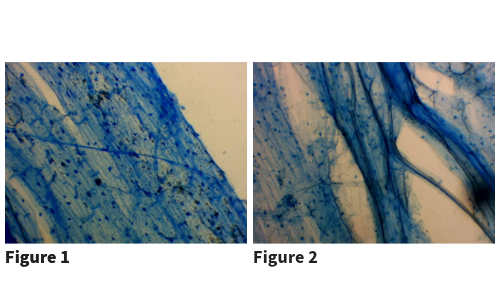The pen is mightier than the sword
Posted on August 31, 2023 by Dr Tom Wilkes
Dr Tom Wilkes takes us behind the scenes of their latest publication 'Alternative inks for arbuscular mycorrhizal root staining' published in Access Microbiology.
My name is Dr Tom Wilkes, I’m a research fellow at Cranfield University, UK, with a background in soil microbiomes and plant-microbial interactions.
My work originated in medical microbiomes and infectious diseases before transitioning to environmental microbiomes and microbial-plant interactions in the search for fungal derived antimicrobial compounds in woodland soils. I was able to take soil microbiology further, specialising in crop symbiotic mycorrhiza, focusing on the implications of soil management and cropping systems towards arbuscular mycorrhizal fungal interactions with developing crops, their overall yields, and soil quality.
Mycorrhiza have been linked to the initial plant colonisation of land over 400 million years ago. They play a vital role in maintaining soil quality through the production of high carbon content compounds which are deposited in soils, contributing to increased soil stability, and reducing soil erosion. Arable land management, such as tillage, damages and destroys mycorrhizal networks and the hard work they’ve put into increasing soil quality.

Figure 1: Wheat root stained with Sheaffer blue ink. Wilkes et al. 2020. Figure 2: Wheat root stained with Parker washable blue ink. Wilkes T.I. 2023
Several methods are currently employed to assess and quantify arbuscular mycorrhiza (AM), including staining of host root systems for rapid detection and quantification of symbiosis. This method does not require large scale lab equipment and can be done with relative ease by anyone, anywhere in the world. My most recent paper, a short communication published in Access Microbiology, finds alternative pen inks that can be used to stain AM fungi, building upon my previous work that developed a more clear and reliable staining protocol with Sheaffer blue pen ink. However, Sheaffer blue ink has become more difficult to obtain in the past year, hindering the previously developed procedure. Therefore, my short communication looked to address this with widely available commercial inks for AM fungal staining that perform as well as Sheaffer blue. I determined that Parker blue ink is a good substitute for Sheaffer blue.
I hope that with the most recent addition of different inks, the procedure will become more widely available to those in areas that may not be able to acquire the original ink and, therefore, widen the applications mycorrhizal staining.
Thumbnail Image: iStock/Pajomend
Figure 1: Wilkes TI, Warner DJ, Edmonds-Brown V, Davies KG, Denholm I. A comparison of methodologies for the staining and quantification of intracellular components of arbuscular mycorrhizal fungi in the root cortex of two varieties of winter wheat. Access Microbiology 2020; 2:000083
Figure 2: Wilkes, T.I Alternative inks for arbuscular mycorrhizal staining, Access Microbiology, 2023, 5(8), DOI 10.1099/acmi.0.000618.v4

